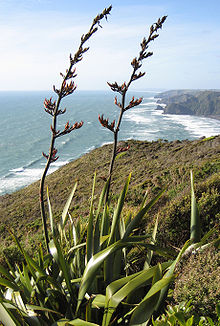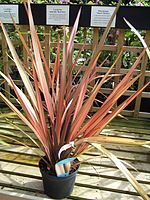- Phormium
-
New Zealand flax 
Scientific classification 
Kingdom: Plantae clade: Angiosperms clade: Monocots Order: Asparagales Family: Xanthorrhoeaceae Subfamily: Hemerocallidoideae Genus: Phormium Species Phormium cookianum
Phormium tenaxNew Zealand flax describes common New Zealand perennial plants Phormium tenax and Phormium cookianum, known by the Māori names harakeke and wharariki respectively. They are quite distinct from the Northern Hemisphere plant known as flax (Linum usitatissimum), but the genus was given the common name 'flax' by Anglophone Europeans as it too could be used for its fibres.
New Zealand flax produces long leaf fibres that have played an important role in the culture, history, and economy of New Zealand. Phormium tenax occurs naturally in New Zealand and Norfolk Island, while Phormium cookianum is endemic to New Zealand. Both species have been widely distributed to temperate regions of the world as economic fibre and ornamental plants.[1]
The naturalist Jacques Labillardière collected indigenous flax plants when French ships visited the far north of the North Island of New Zealand in 1793. He had noted the many uses the Māori had put the plant to and in 1803 gave it the scientific name Phormium, meaning "basket" or "wickerwork", and tenax meaning "tenacity" or "holding fast".
Phormium tenax is found mainly in swamps or low lying areas but will grow just about anywhere and is also much propagated in gardens as an evergreen decorative plant, both in New Zealand and now worldwide. Phormium tenax is an herbaceous perennial monocot. Monocot classification has undergone significant revision in the past decade, and recent classification systems (including the Angiosperm Phylogeny Group) have found Phormium tenax to be closely related to daylilies (Hemerocallis). Phormium tenax formerly belonged to the family Agavaceae and many classification systems still place it there.
Contents
Appearance
The tough, sword-shaped leaves grow up to three metres long and up to 125 mm wide. They are usually darkish green but sometimes have coloured edges and central ribs. Cultivated varieties range from light green through pink to deep russet bronze. There are numerous variegated cultivars with leaves marked by contrasting stripes in shades of green, red, bronze, pink and yellow.
The rigid flower stalks can be up to five metres long, projecting high above the foliage. In November (in New Zealand) they produce clumps of curving tube-like flowers which turn bright red when mature. These produce unusually large quantities of nectar to attract all nectar feeding birds such as the tui and insects. The seedpods that develop after pollination, each contain hundreds of seeds which are later widely dispersed by the wind.
Use by Māori
Main article: Māori traditional textilesWhen the Māori came to New Zealand, they brought with them the paper mulberry plant from which they made bark cloth for clothing. The paper mulberry did not flourish and a substitute material was found in the native flax. As Captain Cook wrote: “Of the leaves of these plants, with very little preparation, they (the Māori) make all their common apparel; and of these they make also their strings, lines and cordage …”. They also made baskets, mats, and fishing nets from the undressed flax. The Māori practised advanced weft twining in phormium fibre cloaks.[2]
Plaiting and weaving (raranga) the flax fibres into baskets were but only two of the great variety of uses made of flax by Māori who recognised nearly 60 varieties, and who carefully propagated their own flax nurseries and plantations throughout the land.
Leaves were cut near the base of the plant using a sharp mussel shell or specially shaped rocks, more often than not greenstone (jade, or pounamu). The green fleshy substance of the leaf was stripped off, again using a mussel shell, right through to the fibre which went through several processes of washing, bleaching, fixing, softening, dyeing and drying.
The fibres of various strengths were used to fashion eel traps (hinaki), surprisingly large fishing nets (kupenga) and lines, bird snares, cordage for ropes, baskets (kete), bags, mats, clothing, sandals (paraerae), buckets, food baskets (rourou), and cooking utensils etc.
The flax fibre called muka is laboriously washed, pounded and hand wrung to make soft for the skin. Muka whenu (cords)form the basecloth for intricate kākahu (cloak/garments) such as the kahu huruhuru (feather cloak), a highly prized traditional garment. Cloaks adorned with colourful feathers from the native birds i.e. huia, kiwi, tui, kererū (woodpigeon) and kākā (parrot), will reference the main type used i.e. Kahu Kiwi, Kahu Kākā, etc.
The handmade flax cording and ropes had such great tensile strength that they were used to successfully bind together sections of hollowed out logs to create huge ocean-going canoes (waka). It was also used to make rigging, sails and lengthy anchor warps, and roofs for housing.
Frayed ends of flax leaves were fashioned into torches and lights for use at night. The dried flower stalks, which are extremely light, were bound together with flax twine to make river rafts called mokihi.
Medicinal properties
For centuries, Māori have drawn the abundant nectar from the flowers as a general sweetener. Myriad medicinal uses makes the plant even more important to the everyday health of Māori.
Boiled and crushed harakeke roots are applied externally as a poultice for boils, tumours and abscesses, as well as to varicose ulcers.
Juice from the pounded roots can be generally used as a disinfectant, and taken internally to relieve constipation or expel worms. It has also been applied to bullet or bayonet wounds.
The gum-like sap produced by harakeke contains enzymes that give it blood clotting and antiseptic qualities to help healing processes. Māori are fully aware of its curative properties and that it is a mild anaesthetic, and apply the sap to boils and various wounds, to aching teeth, to rheumatic and associated pains, ringworm and various skin irritations, and scalds and burns.
Splints can be fashioned from korari (flower stalks) and leaves, and fine cords of muka fibre utilise the styptic properties of the gel before being used to stitch wounds. Harakeke leaves make excellent bandages and can secure broken bones much as plaster is used today. The pulp of pounded leaves can also be applied as dressings.
Research into modern medicinal and cosmetic uses is still being carried out in New Zealand.
Oil from New Zealand flax seed was first[citation needed] commercially produced in 1993 by the Waihi Bush organic farm in the South Island.[3] New Zealand flax seed oil has high levels of Omega-3, and provides an alternative to taking fish oil. New oil blends with other ingredients are being researched and produced. Flax seed oil that can be bought in many countries (aka linseed oil) is extracted from the seeds of the European flax, a plant that belongs to a completely different plant family.
As a paper fibre
Since colonial times the fibre from Phormium tenax has been used for papermaking. Several times the possibility of commercial production has been investigated. Currently it is used by artists and craftsmen producing handmade papers.
Defence uses
During the early Musket Wars and later New Zealand land wars, Māori used large, thickly woven flax mats to cover entrances and lookout holes in their "gunfighter's pā" fortifications. Some warriors wore coats of heavily-plaited Phormium tenax, which gave defense characteristics similar to a medieval gambeson, even slowing musket balls to be wounding rather than deadly[citation needed].
International trade
In the very early 19th century the quality of rope materials made from New Zealand flax was already widely known internationally,[4] as was the quality of New Zealand trees which were used for spars and masts, and the Royal Navy was one of the very largest customers.
The flax trade burgeoned, especially after male Māori recognised the advantages of trade and adapted to helping in the harvesting and dressing of flax which had previously been done exclusively by females, "Whole tribes sometimes relocated to swamps where flax grew in abundance but where it was decidedly unhealthy to live. The taking of slaves increased - slaves who could be put to work dressing flax...".[5]
However, trading for flintlock muskets led to an arms race between tribes, and the ensuing conflicts known as the "Musket Wars" decimated many tribes.
There was an active industry harvesting and processing flax at Foxton, New Zealand until demand declined due to the depression of the 1930s. There was also research program conducted by John Stuart Yeates at the nearby Massey University (then Massey College).
Cultivars
In recent years there has been a dramatic increase in the number of Phormium cultivars available. The 2005-2006 edition of the Royal Horticultural Society Plant Finder listed 75 cultivars. As early as the 1920s it was recognised that Ploidy plays a role in some cultivars.[6]
References
- ^ Extraction, content, strength, and extension of Phormium variety fibres prepared for traditional Maori weaving, New Zealand Journal of Botany, 2000, Vol. 38: pg. 469.
- ^ John Gillow and Bryan Sentance, World Textiles: A Visual Guide to Traditional Techniques, London: Thames & Hudson, 2004, p. 64, 220.
- ^ The Waihi Bush Story, Waihi Bush Organic Farm.
- ^ "History of the Phormium Fibre Export Trade", 1966 "An Encyclopaedia of New Zealand"
- ^ A dangerous people whose only occupation is war: Maori and Pakeha in 19th century New Zealand Journal of Pacific History, 1997, Christina A. Thompson
- ^ "Papers Past — Evening Post — 21 December 1929 — FLAX RESEARCH". paperspast.natlib.govt.nz. 2011 [last update]. http://www.paperspast.natlib.govt.nz/cgi-bin/paperspast?a=d&cl=search&d=EP19291221.2.108&srpos=1&. Retrieved 24 October 2011.
External links
Categories:- Xanthorrhoeaceae genera
- Hemerocallidoideae
- Fiber plants
- Medicinal plants
- Crops originating from New Zealand
- History of Oceanian clothing
Wikimedia Foundation. 2010.


